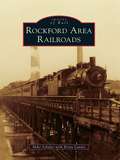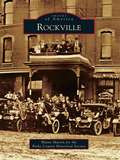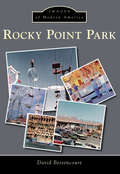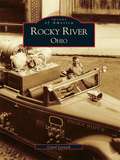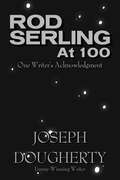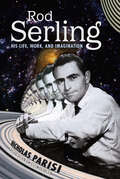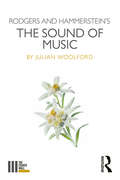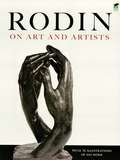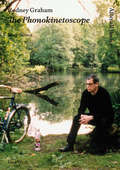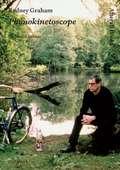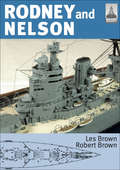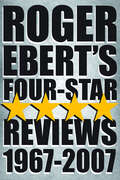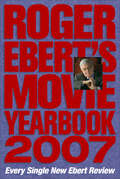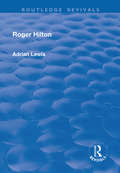- Table View
- List View
Rockers and Rollers: A Full-Throttle Memoir
by Brian Johnson“Surprisingly refreshing . . . You don’t need to know anything about AC/DC to appreciate his funny and highly descriptive writing about [cars].” —Publishers WeeklyFrom “Pink Cadillac” to “Low Rider” to “Little Red Corvette,” rock music has always had a racy love affair with cars. And AC/DC lead singer Brian Johnson is not only a rock legend, second-to-none at infusing razor-sharp lyrics with the screaming metal energy of a true rock and roller, but also a dyed-in-the-wool car fanatic. Books like AC/DC: Maximum Rock and Roll and Why AC/DC Matters revealed the secrets of the world’s greatest rock band—now, in Rockers and Rollers, fans will get a rare, riveting window into Brian Johnson’s other driving passion, his love for automobiles. From teenage memories in the backs of beat-up coups to a side career as a racecar driver, Johnson shares his tantalizing life story—a memoir told through his lifelong love affair with cars.“A fast, fun read . . . Johnson’s gifts for storytelling and humor shine.” —The New York Times
Rockford & Interurban Railway
by Brian Landis Mike SchaferWith today's America dominated by the automobile, it is difficult to believe that until the 1920s nearly 100 percent of the US population traveled via rail. Conventional passenger-train service spread rapidly by the 1850s, but another form of rail transportation did not emerge until the turn of the 20th century: the interurban. Almost always electric, interurbans linked cities with burghs. Rockford, one of Illinois's three largest urban centers during the 20th century, enjoyed a system appropriately named the Rockford & Interurban, dating from the city's horse-drawn streetcars of the 1880s. By World War I, the Rockford & Interurban ran from downtown Rockford to Cherry Valley and Belvidere; Winnebago, Pecatonica, and Freeport; Roscoe and Rockton; and Beloit and Janesville, Wisconsin. The Rockford & Interurban enjoyed a supernova of success, rising quickly in popularity before slowly dying when the automobile became widespread in the 1920s; the Great Depression finished the job in 1936.
Rockford Area Railroads
by Brian Landis Mike SchaferRailroads were key to Rockford's rise as a thriving manufacturing and commercial center. With an area population of over 200,000 residents and a reputation for manufactured goods, Rockford had a critical need for railroads into the bust years of the 1970s. Eventually four railroads rose to prominence in Rockford, all of them Class 1 carriers: the Chicago and North Western; Chicago, Burlington, and Quincy; the Chicago, Milwaukee, St. Pau,l and Pacific (the Milwaukee Road); and Illinois Central. For nearly a century, these four roads--all of them esteemed Midwestern railroads--carried the bulk of freight and passengers arriving and departing Rockford, Davis Junction, and Loves Park by rail. Two other smaller railways, the Chicago, Milwaukee, and Gary and the Rockford and Interurban, also played a part in Rockford's railroad history and are spotlighted in this volume.
Rockingham Speedway
by Rick Houston Bryan HallmanLocated in the Sandhills region of North Carolina, Rockingham Speedway opened in 1965. The legendary Curtis Turner made his return to NASCAR® with a victory in the track's inaugural event in 1965, while local favorite Benny Parsons clinched the 1973 championship here. A 1994 victory at Rockingham clinched that year's NASCAR championship for Dale Earnhardt. It was his seventh title, tying Earnhardt with Richard Petty for most in the sport's history. The facility formerly known as North Carolina Motor Speedway and respectfully nicknamed "The Rock" experienced a rebirth under the direction of new owner Andy Hillenburg. Rockingham Speedway showcases the rich NASCAR history of this North Carolina track.
Rockville (Images of America)
by Parke County Historical Society Blaine MartinRockville began in 1824 as the seat of justice for the newly established Parke County. A small brick courthouse was built, and a fledgling community soon sprang up around it. Within a short time, blacksmiths, furniture builders, harness makers, grocers, druggists, and dry goods salesmen were calling the new public square home. Then over a period of 13 years, beginning in 1870, the face of Rockville was drastically altered as fires destroyed the early buildings. The newly resurrected town would look quite different. As the rebuilding occurred, an exceptional example of small-town Italianate architecture emerged. This new Rockville looked much different than its haphazard Colonial-style predecessor. Three-story brick and stone buildings replaced haphazard one- and two-story wood frame structures; concrete sidewalks replaced wooden walkways; awnings, ornate cornices, and large architectural iron and glass storefronts became the standard. It was during these years that Rockville began to resemble the quintessential American small town it is today.
Rocky Horror: A Behind-the-Scenes Look at the Cult Classic
by Tim Mohr Mick RockStep behind the curtain of The Rocky Horror Picture Show with photographer Mick Rock in this one-of-a-kind slipcased collection of rarely seen photographs and behind-the-scenes anecdotesKnown as “the man who shot the seventies,” Mick Rock had exclusive access to the set during the original filming of the now-iconic 1975 movie—and now, in honor of its 50th anniversary, his personal archive is wide open.This stunning volume captures the raw, behind-the-scenes magic of a film that would go on to become a cultural phenomenon. From candid moments with Tim Curry, Susan Sarandon, and Richard O’Brien to intimate shots of the cast between takes, every page offers a glimpse into the bold, bizarre, and beautiful world of Rocky Horror as it was being brought to life.Featuring a foreword by creator Richard O’Brien and hundreds of rare photographs, this stunning gift book is a visual love letter to the wild energy, fearless creativity, and sheer chaos that turned a low-budget musical into a beloved masterpiece. Alongside these vivid behind-the-scenes snapshots and anecdotes, readers also gain VIP access to interviews with members of the original cast and crew, as well as famous performers and creatives who are among the film’s most fervent fans, including Joan Jett, Billy Corgan, Courtney Love, Juliette Lewis, Jinkx Monsoon, Duff McKagan, Anna Sui, Karen O, Trixie Mattel, Peaches, Norman Reedus, Cassandra Peterson (aka Elvira, Mistress of the Dark), and many, many more.Whether you’re a devoted fan or just discovering the Time Warp, Mick Rock’s Rocky Horror is dripping with the glam, grit, and rebellious spirit that made the movie a revolution in platform heels. Don’t just shiver with antici—pation; dive into this timeless tribute and celebrate the global phenomenon that continues to resonate with audiences, generation after generation.
Rocky Mount & Nash County (Images of America)
by Monika S. FlemingThe picturesque beauty and unique history of Rocky Mount, North Carolina, are surpassed only by the strength of character of the region's citizens. In this new and singular pictorial history, all of these wonderful attributes are portrayed in vibrant detail. The first historical retrospective of Nash County to appear in 20 years, Rocky Mount and Nash County encompasses many of the county's smaller towns and crossroads and chronicles the development of industry, agriculture, and business, as well as the remarkable people who call the region home, in rich visual imagery and intriguing anecdotes.
Rocky Point Park
by David BettencourtIn 1938, a tremendous hurricane devastated southern New England, including Rocky Point Park. The shore dining hall was washed away, and the roller coaster lay in ruins. Owners began to look into other options for this beautiful 80 acres of land along the coastline of Narragansett Bay. The park's future was in jeopardy until 1948, when Providence businessman Vincent Ferla bought it and brought it back to life. He revitalized the midway and brought in new and exciting rides, and on the park's first day back, more than 35,000 people visited. The park thrived for nearly 50 years until its eventual closure in 1995. Today, this scenic spot along the Atlantic Ocean has been returned to the people of Rhode Island as a nature preserve and is flourishing once again.
Rocky River Ohio
by Carol LestockRocky River, Ohio, was originally part of a large township that encompassed Lakewood, Rocky River, Fairview Park, and the West Park neighborhood of Cleveland. Gideon Granger, an early settler to the region, believed that this area at the mouth of the Rocky River would one day be a major city and port, surpassing Cleveland in size and importance. Happily, Granger's vision did not come true. Rocky River continues to remain a small town in every good sense of the word. The early history and development of Rocky River unfold through the images collected in this volume. This visual history serves as a tour guide to the town's past, from its beginning through to the present day. For the first time readers will see the history of Rocky River, its most notable landmarks and events, and be able to relate it all to the town they know today.
Rod Serling at 100: One Writer's Acknowledgment
by Joseph DoughertyEmmy-winning writer and lifelong Rod Serling fan Joseph Dougherty (thirtysomething, Pretty Little Liars) takes a deep dive into the writing of the Twilight Zone creator on the occasion of his 100th birthday.The year 2024 marks the centenary of Rod Serling, creator of The Twilight Zone and Night Gallery. Emmy-winning writer Joseph Dougherty (thirtysomething, Pretty Little Liars) picked this special anniversary to reflect on Serling and his contributions to television drama. An appreciation and exploration of the six-time Emmy-winning writer&’s catalogue, Rod Serling at 100: One Writer&’s Acknowledgment looks at some of Serling&’s best known work and also some of his least acknowledged, inviting a new perspective on a master storyteller. In the process, Dougherty takes a personal look at the time he spent in The Twilight Zone that led to his own award-winning writing career
Rod Serling: His Life, Work, and Imagination
by Nicholas ParisiLong before anyone had heard of alien cookbooks, gremlins on the wings of airplanes, or places where pig-faced people are considered beautiful, Rod Serling was the most prestigious writer in American television. As creator, host, and primary writer for The Twilight Zone, Serling became something more: an American icon. When Serling died in 1975, at the age of fifty, he was the most honored, most outspoken, most recognizable, and likely the most prolific writer in television history. Though best known for The Twilight Zone, Serling wrote over 250 scripts for film and television and won an unmatched six Emmy Awards for dramatic writing for four different series. His filmography includes the acclaimed political thriller Seven Days in May and cowriting the original Planet of the Apes. In great detail and including never-published insights drawn directly from Serling’s personal correspondence, unpublished writings, speeches, and unproduced scripts, Nicholas Parisi explores Serling’s entire, massive body of work. With a foreword by Serling’s daughter, Anne Serling, Rod Serling: His Life, Work, and Imagination is part biography, part videography, and part critical analysis. It is a painstakingly researched look at all of Serling’s work—in and out of The Twilight Zone.
Rodeo (Images of America)
by Jennifer DowlingRodeo, located on the east shore of San Pablo Bay, was envisioned as the meatpacking center of the West when it was established by the Union Stockyard Company in 1890. That vision failed, but the town continued attracting residents for jobs at the nearby Hercules powder works, Selby smelter, and Oleum refinery. By the 1940s, a war-based industrial buildup made Rodeo's population surge, and this was followed by a postwar boom in housing and retail construction. During these prosperous years, Rodeo was a regional hub for fishing and boating. Times have changed, but the images in these pages recall Rodeo's early years--the marina, businesses and homes, schools, civic officials, and local industry, as well as the town's celebrations, such as the Holy Ghost and Aquatic Festivals.
Rodgers and Hammerstein's The Sound of Music (The Fourth Wall)
by Julian Woolford'Blossom of snow may you bloom and grow, Bloom and grow forever' Often dismissed as kitsch sentimentalism, Rodgers and Hammerstein’s The Sound of Music has proven an enduringly popular and surprisingly influential cultural icon, both within the field of musical theatre and the wider world. The Broadway production won five Tony Awards, the London production became the longest-running West End musical, and the movie version was the highest-grossing film of all time. This book examines how the musical heralded the end of an era on Broadway; its reinvention of history and biography; how the film has influenced future stage productions; the ways in which it put child performers centre stage; and how, nearly 60 years after its stage debut, the musical still has a direct impact on the modern world, from the United States to the Middle East. In this series of short essays, Julian Woolford re-examines the musical from seven different perspectives, revealing the ways in which it continues to impact the 21st century.
Rodin on Art and Artists
by Auguste RodinThe greatest sculptor of the nineteenth century discusses his philosophy of life with a close friend in this fascinating and informative artistic testament. Auguste Rodin spoke candidly to his protégé, Paul Gsell, who recorded the master's thoughts not only about the technical secrets of his craft, but also about its aesthetic and philosophical underpinnings.Here is the real Rodin--relaxed, intimate, open, and charming--offering a wealth of observations on the relationship of sculpture to poetry, painting, theater, and music. He also makes perceptive comments on Rembrandt, Michelangelo, Raphael, and other great artists, and he shares revealing anecdotes about Hugo, Balzac, and others who posed for him. Seventy-six superb illustrations of the sculptor's works complement the text, including St John the Baptist Preaching, The Burghers of Calais, The Thinker, and many others, along with a selection of exuberant drawings and prints.
Rodney Graham: Phonokinetoscope (One Work)
by Shepherd SteinerAn examination of the complex and subtle world on display in Rodney Graham's film of an LSD-inflected bicycle ride. Rodney Graham's Phonokinetoscope (2001) is a five-minute 16mm film loop in which the artist is seen riding his Fischer Original bicycle through Berlin's Tiergarten while taking LSD, to the soundtrack of a fifteen-minute song (written and performed by Graham) recorded on a vinyl LP. The turntable drives the projection of the film; the film starts when the needle is placed on the record and stops when the needle is taken off. Graham's ride evokes the Swiss scientist Albert Hoffman's famous 1943 bicycle ride home after an experimental dose of LSD as well as Paul Newman's backward-facing ride in Butch Cassidy and the Sundance Kid; the accompanying music presents a thicket of riffs and borrowings. As the images and visual details repeat in the film's endless loop, the artist's Phonokinetoscope refers to a surprising number of works of art and literature, displaying a world rich with subtle meaning. In this illustrated study of Phonokinetoscope, Shep Steiner describes the work as marking Graham's transition into a new medium. Steiner positions Graham's practice in relation to postminimalist practice and that of other artists including Dan Graham, but especially, Ian Wallace and Jeff Wall; considers Graham's rhetoric of playfulness; and finally, beyond the web of references, argues for a notion of allegory and memory theater keyed to the durational work yet satisfying the aesthetic standards of static art. Phonokinetoscope, Steiner argues, looks back to Graham's earlier works focusing on the notion of protocinema and forward to his later musical preoccupations.
Rodney Graham: The Phonokinetoscope
by Shep SteinerRodney Graham's "Phonokinetoscope" (2001) is a five-minute 16mm film loop in which the artist is seen riding his Fischer Original bicycle through Berlin's Tiergarten while taking LSD, to the soundtrack of a fifteen-minute song (written and performed by Graham) recorded on a vinyl LP. The turntable drives the projection of the film; the film starts when the needle is placed on the record and stops when the needle is taken off. Graham's ride evokes the Swiss scientist Albert Hoffman's famous 1943 bicycle ride home after an experimental dose of LSD as well as Paul Newman's backward-facing ride in "Butch Cassidy and the Sundance Kid"; the accompanying music presents a thicket of riffs and borrowings. As the images and visual details repeat in the film's endless loop, the artist's "Phonokinetoscope" refers to a surprising number of works of art and literature, displaying a world rich with subtle meaning. In this illustrated study of "Phonokinetoscope," Shep Steiner describes the work as marking Graham's transition into a new medium. Steiner positions Graham's practice in relation to postminimalist practice and that of other artists including Dan Graham, but especially, Ian Wallace and Jeff Wall; considers Graham's rhetoric of playfulness; and finally, beyond the web of references, argues for a notion of allegory and memory theater keyed to the durational work yet satisfying the aesthetic standards of static art. "Phonokinetoscope," Steiner argues, looks back to Graham's earlier works focusing on the notion of protocinema and forward to his later musical preoccupations.
Rodney and Nelson (ShipCraft #23)
by Robert Brown Les Brown&“Simply the best reference for any model maker&” on the most instantly recognizable British battleships in history (Warship World). The ShipCraft series provides in-depth information about building and modifying model kits of famous warship types. Lavishly illustrated, each book takes the modeler through a brief history of the subject class, highlighting differences between sisterships and changes in their appearance over their careers. This includes paint schemes and camouflage, featuring color profiles and highly detailed line drawings and scale plans. The modeling section reviews the strengths and weaknesses of available kits, lists commercial accessory sets for super-detailing of the ships, and provides hints on modifying and improving the basic kit. This is followed by an extensive photographic survey of selected high-quality models in a variety of scales, and the book concludes with a section on research references—books, monographs, large-scale plans and relevant websites. The two ships covered in this volume were the only capital ships designed and built between the wars—a special concession of the Washington Treaty&’s ban on new battleships—and they were unlike anything before them, with the superstructure three-quarters aft and all main armament turrets forward of the bridge. During the war, Nelson survived mine and torpedo damage, while Rodney played a major part in the destruction of the Bismarck, both surviving to be broken up post-war.
Roger Bacon: The First Scientist
by Brian CleggBack in thirteenth-century Europe, in the early years of the great universities, learning was spiced with the danger of mob violence and a terrifyingly repressive religious censorship. Roger Bacon, a humble and devout English friar, seems an unlikely figure to challenge the orthodoxy of his day - yet he risked his life to establish the basis for true knowledge.Born c.1220, Bacon was passionately interested in the natural world and how things worked. Such dangerous topics were vetoed by his Order, and it was only when a new Pope proved sympathetic that he began compiling his encyclopaedia on everything from optics to alchemy - the synopsis took a year and ran to 800,000 words and he was never to complete the work itself. Sadly, the enlightened Pope died, and Bacon was tried as a magician and incarcerated for ten years. Legend transformed Bacon into a sorcerer, 'Doctor Mirabilis', yet he taught that all magic was based on fraud, and his books were the first flowering of the scientific thinking that would transform our world. He advanced the understanding of optics, made geographical breakthroughs later used by Columbus, predicted everything from horseless carriages to the telescope, and stressed the importance of mathematics to science, a significance ignored for 400 years. His biggest contribution was to insist that a study of the natural world by observation and exact measurement was the surest foundation for truth. Clegg uncovers the realities of life in a medieval university and friary, setting out the shadowy facts of Bacon's life alongside his writings. The result is both a fascinating biography and a picture of the age.
Roger Bacon: The First Scientist
by Brian CleggBack in thirteenth-century Europe, in the early years of the great universities, learning was spiced with the danger of mob violence and a terrifyingly repressive religious censorship. Roger Bacon, a humble and devout English friar, seems an unlikely figure to challenge the orthodoxy of his day - yet he risked his life to establish the basis for true knowledge.Born c.1220, Bacon was passionately interested in the natural world and how things worked. Such dangerous topics were vetoed by his Order, and it was only when a new Pope proved sympathetic that he began compiling his encyclopaedia on everything from optics to alchemy - the synopsis took a year and ran to 800,000 words and he was never to complete the work itself. Sadly, the enlightened Pope died, and Bacon was tried as a magician and incarcerated for ten years. Legend transformed Bacon into a sorcerer, 'Doctor Mirabilis', yet he taught that all magic was based on fraud, and his books were the first flowering of the scientific thinking that would transform our world. He advanced the understanding of optics, made geographical breakthroughs later used by Columbus, predicted everything from horseless carriages to the telescope, and stressed the importance of mathematics to science, a significance ignored for 400 years. His biggest contribution was to insist that a study of the natural world by observation and exact measurement was the surest foundation for truth. Clegg uncovers the realities of life in a medieval university and friary, setting out the shadowy facts of Bacon's life alongside his writings. The result is both a fascinating biography and a picture of the age.
Roger Ebert's Four-Star Reviews 1967–2007
by Roger EbertSpanning the length of Roger Ebert's career as the leading American movie critic, this book contains all of his four-star reviews written during that time. A great guide for movie watching.
Roger Ebert's Movie Yearbook 2007: Every Single New Ebert Review
by Roger EbertThe most-trusted film critic in America." --USA Today Roger Ebert actually likes movies. It's a refreshing trait in a critic, and not as prevalent as you'd expect." --Mick LaSalle, San Francisco ChronicleAmerica's favorite movie critic assesses the year's films from Brokeback Mountain to Wallace and Gromit: The Curse of the Were-Rabbit. Roger Ebert's Movie Yearbook 2007 is perfect for film aficionados the world over.Roger Ebert's Movie Yearbook 2007 includes every review by Ebert written in the 30 months from January 2004 through June 2006-about 650 in all. Also included in the Yearbook, which is about 65 percent new every year, are:* Interviews with newsmakers such as Philip Seymour Hoffman, Terrence Howard, Stephen Spielberg, Ang Lee, and Heath Ledger, Nicolas Cage, and more.* All the new questions and answers from his Questions for the Movie Answer Man columns.* Daily film festival coverage from Cannes, Toronto, Sundance, and Telluride.*Essays on film issues and tributes to actors and directors who died during the year.
Roger Ebert's Movie Yearbook 2009
by Roger EbertNobody has been more important in telling Americans why we should love film than Roger Ebert. —Michael Shamberg, Editor and PublisherPulitzer Prize-winning film critic Roger Ebert presents more than 650 full-length critical movie reviews, along with interviews, essays, tributes, film festival reports, and Q and As from Questions for the Movie Answer Man.Roger Ebert's Movie Yearbook 2009 collects more than two years' worth of his engaging film critiques. From Bee Movie to Darfur Now to No Country for Old Men, and from Juno to Persepolis to La Vie en Rose, Roger Ebert's Movie Yearbook 2009 includes every review Ebert has written from January 2006 to June 2008.Also included in the Yearbook, which boasts 65 percent new content, are:* Interviews with newsmakers, such as Juno director Jason Reitman and Jerry Seinfeld, a touching tribute to Deborah Kerr, and an emotional letter of appreciation to Werner Herzog.* Essays on film issues, and tributes to actors and directors who died during the year.* Daily film festival reports from Cannes, Toronto, Sundance, and Telluride.* All-new questions and answers from his Questions for the Movie Answer Man columns.
Roger Ebert's Movie Yearbook 2010
by Roger EbertRoger Ebert's Movie Yearbook 2010 is the ultimate source for movies, movie reviews, and much more. For nearly 25 years, Roger Ebert's annual collection has been recognized as the preeminent source for full-length critical movie reviews, and his 2010 yearbook does not disappoint.The yearbook includes every review Ebert has written from January 2007 to July 2009. It also includes interviews, essays, tributes, and all-new questions and answers from his Questions for the Movie Answer Man columns. Fans get a bonus feature, too, with new entries to Ebert's Little Movie Glossary.This is the must-have go-to guide for movie fanatics.
Roger Ebert's Movie Yearbook 2013: Every Single New Ebert Review
by Roger EbertRoger Ebert&’s &“criticism shows a nearly unequaled grasp of film history and technique, and formidable intellectual range. . . .&” —New York TimesPulitzer Prize–winning film critic Roger Ebert presents more than 600 full-length critical movie reviews, along with interviews, tributes, and journal entries inside Roger Ebert&’s Movie Yearbook 2013.It includes every movie review Ebert has written from January 2010 to July 2012.Also included in the Yearbook:In-depth interviews with newsmakers and celebritiesTributes to those in the film industry who have passed away recentlyEssays on the Oscars, reports from the Toronto Film Festival, and entries into Ebert's Little Movie Glossary
Roger Hilton
by Adrian LewisThis title was first published in 2003. Twenty-seven years after his death, Roger Hilton's reputation as a leading figure in British 'abstract expressionism' continues to rise. Following the major retrospective exhibition at the Hayward Gallery in 1993 and the drawings survey at the Tate St Ives in 1997, this lavishly illustrated account is the first to provide a comprehensive overview of the life and work of this important artist. Hilton's extraordinary career is discussed in all its phases, from the intriguing earliest explorations in paint to the inception of his first abstract pieces around 1950 and the complex and intriguing interchanges of imagery and form that mark his final works. Adrian Lewis explains the artist's mature works as both attracting the viewer and resisting easy reading, and discusses in detail the artist's debt to the Ecole de Paris and his relation to the notion of the 'act of painting' that pervaded post-war culture.


